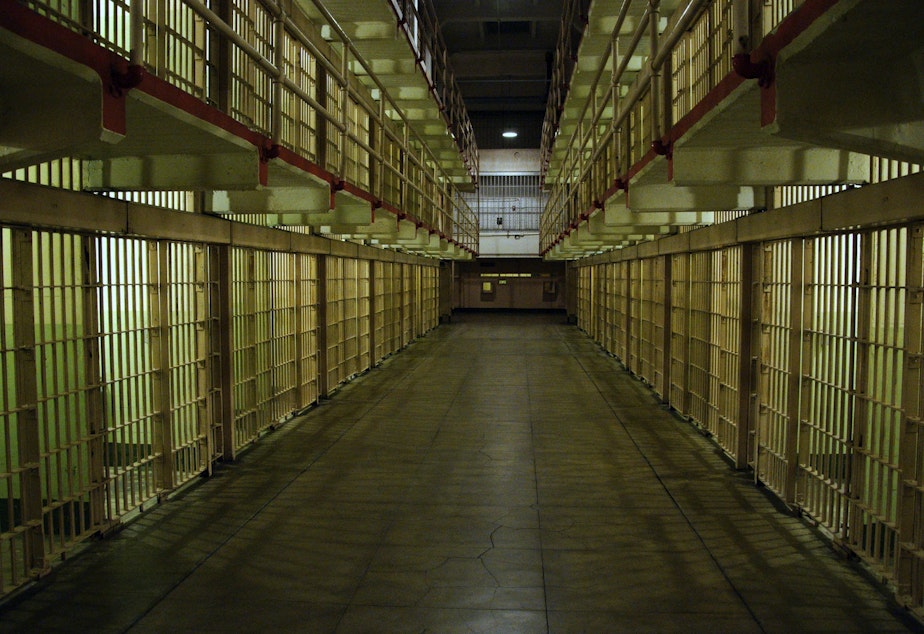Inmates sent to Covid hot spot in central Washington to relieve overcrowding at their prison; others sleep on floor

Five months into the coronavirus pandemic, nearly 300 inmates and staff have tested positive for the coronavirus at the Coyote Ridge Corrections Center in Connell, Washington.
Inmates continue to be transferred to and from this Covid-19 hotspot to offset low prison capacity at other state facilities.
This has inmates and their families worried about spread of the virus.
Nineteen inmates were moved to Coyote Ridge on July 30, from the Washington Corrections Center, to address crowding there, a Department of Corrections spokesperson wrote by email.
These inmates have been tested twice to ensure that they do not have Covid-19, and are “healthy and safe for transfer,” the spokesperson said.
But inmates are complaining that they are too close together, and they are at risk of catching the virus.
At the Washington Corrections Center in Shelton, inmates have reported sleeping on the floor in cells, because of lack of space, according to inmate grievance documents provided to KUOW.
An inmate wrote that he was forced to sleep on the floor in his cell. “This clearly violates the statewide rule and law to the Covid-19 6-feet rule.”
A grievance coordinator with the Department of Corrections responded to the complaint, saying, “There are no state or federal laws that prevent [Department of Corrections] from placing incarcerated individuals on the floor. Though this is not ideal housing for anyone, we have to provide housing for every incarcerated individual sentenced to our jurisdiction.”
He continued: “Currently there is overcrowding at this facility. Social distancing is defined as keeping a minimum of 6 feet between individuals when able to do so.”
Inmate Joshua Clark caught the coronavirus in early June, while housed at Coyote Ridge Corrections Center. The eastern Washington facility has the most confirmed Covid-19 cases of all Washington state prisons — 232 inmates and 65 staff have tested positive for coronavirus thus far.
“They knew it was coming, knew everything going on out there,” Clark said about the prison’s outbreak. “They just thought their staff wasn’t going to bring it into us?”
On June 11, after testing positive, Clark was transported by van — what he calls the “dog catcher bus" — to the Airway Heights Corrections Center in eastern Washington, where he had his vital signs taken, and was loaned a small breathing machine.
Less than a day later, he was sent to the Monroe Correctional Complex, more than 250 miles away.
On June 26, two weeks after Clark was diagnosed with the coronavirus and moved to Monroe, Assistant Secretary Robert Herzog wrote in a memo to all prison staff and inmates that only healthy inmates would be transferred to other prisons from Coyote Ridge.
"We want to reassure you that we will only transfer individuals who have been tested twice for Covid-19 and received negative results from both tests.” A double negative test reduces the risk of faulty outcomes.
Those being transferred would be isolated for 14 days or more, he said.
Clark was sick and confined to his cell most of his time at Monroe. He wasn’t allowed to shower for weeks. He said his cell at Monroe was filthy, and he cleaned it with toilet paper. Inmates are required to clean their own cells upon arrival, and don't know if the previous occupants had the coronavirus.
Clark returned to Coyote Ridge from Monroe three weeks later, on July 3. He was one of about 27 people who moved to Coyote Ridge from Monroe, after having coronavirus. Clark said they were all at different stages of recovery.
This movement of inmates has worried Coyote Ridge inmate families, who brought the subject up in a weekly phone meeting on July 10.
“Why are you guys mixing everyone up still? Positives, negatives, double negatives and inconclusives. You’re not going to stop the spread this way. You guys are also moving around so much there is no way there is not going to be another spike. Can you please clarify why this is happening?” someone asked during the meeting.
“While you may not understand this, the movement that is taking place is being conducted as a means to manage and control the spread,” someone from the department of corrections said. “I know it seems like guys are moving everywhere. It’s very hard to explain what that looks like. It’s actually a very complicated process. It’s a lot of tracking.”
The prison official didn’t provide additional information to the families on movement policies during the call. And prison officials said they weren’t mixing inmates who had positive and negative results.
Meanwhile, advocates insisted that inmates should be moved out of crowded prisons, not between them, to adequately stop the spread of coronavirus.
Some releases have been made already. Gov. Jay Inslee in April announced that he would release about 1,000 inmates in Washington state. They targeted inmates with non-violent offenses nearing the end of their sentence.
Advocates called on the governor to release more, especially the most vulnerable, as two inmates and one employee have died from Covid-19 since the releases began.
Columbia Legal Services on June 24, on behalf of petitioners currently incarcerated within state prisons, asked the Washington State Supreme Court to consider new evidence, in a lawsuit against Gov. Jay Inslee and Stephen Sinclair, secretary for the state’s Department of Corrections.
In a divided opinion, the Washington State Supreme Court recently denied the motion. In their opinion, the slight majority agreed that the issue was one of a separation of powers and that they could not order the Department of Corrections to take any action.

